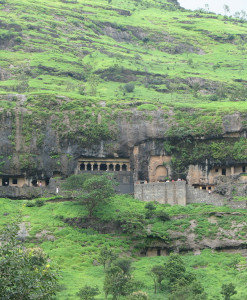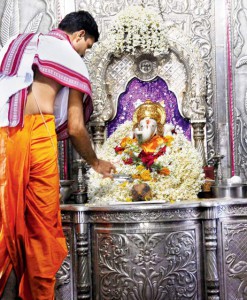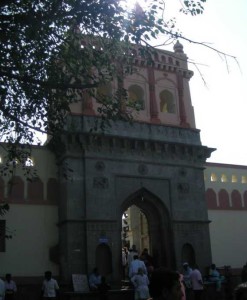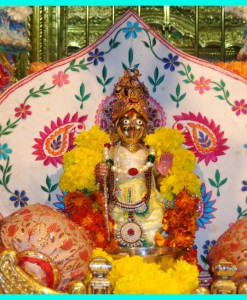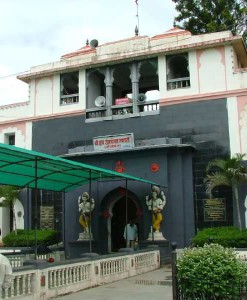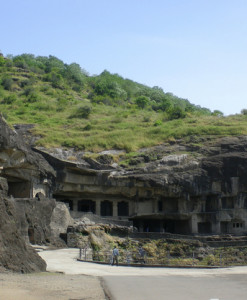No products in the cart.
The Elephanta Caves (natively known as Gharapurichi Leni) are a network of sculpted caves located on Elephanta Island, or Gharapuri (literally “the city of caves”) in Mumbai Harbor, 10 kilometres (6.2 mi) to the east of the city of Mumbai in the Indian state of Maharashtra. The island, located on an arm of the Arabian Sea, consists of two groups of caves—the first is a large group of five Hindu caves, the second, a smaller group of two Buddhist caves. The Hindu caves contain rock cut stone sculptures, representing the Shaiva Hindu sect, dedicated to the Lord Shiva.
In ancient period, the place is variously identified as Puri which is mentioned in the Aihole inscription of Pulakesin II. It seems, different dynasties held their sway over this island, namely, the Konkan-Mauryas, Trikutakas, Chalukyas of Badami, Silaharas, Rashtrakutas, Kalyani Chalukyas, Yadavas of Deogiri, Muslim rulers of Ahmedabad and then by the Portuguese. The Marathas also had this island under their control and from them it passed into the control of the British.
Elephanta Caves, Maharashtra;
The origins of the temple caves, thought to date from about the 7th century, are obscure. It is known, however, that the island was originally called Gharapuri – the Portuguese renamed it Elephanta after they found a large stone elephant near their landing place. The figure collapsed in 1814 and was subsequently moved to the far-off Victoria Gardens and reassembled.
Shortly before the Elephanta temples were created, Bombay had experienced the golden age of the late Guptas, under whom the arts flourished. Sanskrit had been finely polished, and Kalidasa and other writers had helped incite a Hindu religious revival under the court’s liberal patronage. Shaivism, the worship of Shiva, inspired the building of these temples.
Many of Elephanta’s priceless statues were damaged or destroyed by the Portuguese, who apparently used the Hindu gods for target practice. There have also been reports of vandalism and carelessness by modern visitors, so take extra care to avoid damage during your visit.
There are seven cave excavations in the Elephanta group and these are datable from circa 6th – 7th centuries A.D. Among the cave excavations, the Cave 1 is the most impressive which represents the evolved Brahmanical rock-cut architecture. The cave is also famous for the exquisite and vibrant sculptures. On plan it almost resembles the Dumar Lena (Cave 29) of Ellora. The cave has a main entrance on the north with two other openings on the east and west respectively and a central hall with six rows of pillared columns, six in each row except on the western corner, where a shrine of lingam is provided.
On plan, there are three large square recesses divided off by pilasters each of them bearing a gigantic image of a dvarapala. The panel on the east has a figure of ardhanarisvara, a form of Siva with the combined energies of male and female; and on the west figures of Siva and Parvati playing chausar is carved. The central recess holds the most famous and remarkable sculpture of this period known as the Mahesa-murti. It is a colossal bust of the three forms of Siva, the aghora, turbulent and fearsome; tatpurusha, benign and meditative and vamadeva, mild pleasing and lovable. The other notable panels in the main cave are Andhakasuravada murti; cosmic dance of Nataraja; Kalyanasundara murti; Gangadhara murti; Ravana shaking Kailasa and Siva as Lakulisa. A panel depicting Saptamatrikas near the eastern opening is also remarkable.
By Road: Elephanta Island is one of a number of islands in Mumbai Harbor, east of Mumbai, India. The island is easily accessible by ferry from Mumbai, being about 10 kilometres (6.2 mi) from the south east coast of the island city. Boats leave daily from the Gateway of India, taking about an hour each way.
By Rail: The nearest Railway Station to the temple is Mumbai central railway station.
By Air: The Temple can be reached through nearest Mumbai Airport which is well connected with regular domestic flights to Delhi, Mumbai.
You can visit the caves between 9 A.M. to 5 P.M. It is closed on Monday. A spectacular dance festival is held at Elephanta Island every February, hosted by the Maharashtra Tourism Development Corporation (MTDC).
Entrance-Fee:
Citizens of India and visitors of SAARC (Bangladesh, Nepal, Bhutan, Sri Lanka, Pakistan, Maldives and Afghanistan) and BIMSTEC Countries (Bangladesh, Nepal, Bhutan, Sri Lanka, Thailand and Myanmar) – Rs. 10 per head.
Others: US $ 5 or Indian Rs. 250/- per head
(Children up to 15 years free)




